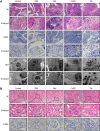Lipid metabolism of Acetobacter pasteurianus and its main components with hypoglycemic effects
- PMID: 40548275
- PMCID: PMC12179894
- DOI: 10.4239/wjd.v16.i6.103370
Lipid metabolism of Acetobacter pasteurianus and its main components with hypoglycemic effects
Abstract
Background: Probiotic Acetobacter pasteurianus is used to treat diabetes, but its specific hypoglycemic substances and mechanisms remain unclear.
Aim: To investigate the components for lipid metabolism of A. pasteurianus and its hypoglycemic effects, providing a basis for its broader application.
Methods: The lipid metabolism of A. pasteurianus under different growth conditions was analyzed using lipidomics. Neutral lipid staining in A. pasteurianus cells and the formation of lipid droplet-like structures were observed using a confocal laser scanning microscope. The neutral lipid components were also analyzed using thin layer chromatography. A diabetic mouse model was established to evaluate the hypoglycemic effects of the main lipid components of A. pasteurianus and their role in repairing tissues such as the pancreas.
Results: After comparing the effects of three culture media, namely, brain heart infusion (BHI) medium with 2% glucose, chromium-rich and zinc-rich medium, and mineral salt medium, A. pasteurianus grew well in BHI containing 2% glucose and produced the most lipids. A total of 583 lipid metabolic products was identified, with higher levels of coenzyme Q9 (CoQ9), oleic acid (OA), and wax ester, but no triacylglycerol was observed. It was found that the components that affected lipid metabolism in A. pasteurianus were mainly CoQ9 and OA. They exhibited hypoglycemic effects comparable to metformin in diabetic mice, repaired damaged pancreatic tissues, and did not cause damage to the liver and spleen.
Conclusion: Under high-nutrient growth conditions, A. pasteurianus contains abundant lipid components, such as CoQ9 and OA, with good hypoglycemic effects.
Keywords: Acetobacter pasteurianus; Hypoglycemic effects; Lipid droplets; Lipid metabolism; Neutral lipids.
©The Author(s) 2025. Published by Baishideng Publishing Group Inc. All rights reserved.
Conflict of interest statement
Conflict-of-interest statement: The authors have no conflicts of interest to declare.
Figures









Similar articles
-
Home treatment for mental health problems: a systematic review.Health Technol Assess. 2001;5(15):1-139. doi: 10.3310/hta5150. Health Technol Assess. 2001. PMID: 11532236
-
Signs and symptoms to determine if a patient presenting in primary care or hospital outpatient settings has COVID-19.Cochrane Database Syst Rev. 2022 May 20;5(5):CD013665. doi: 10.1002/14651858.CD013665.pub3. Cochrane Database Syst Rev. 2022. PMID: 35593186 Free PMC article.
-
Drugs for preventing postoperative nausea and vomiting in adults after general anaesthesia: a network meta-analysis.Cochrane Database Syst Rev. 2020 Oct 19;10(10):CD012859. doi: 10.1002/14651858.CD012859.pub2. Cochrane Database Syst Rev. 2020. PMID: 33075160 Free PMC article.
-
Ear drops for the removal of ear wax.Cochrane Database Syst Rev. 2018 Jul 25;7(7):CD012171. doi: 10.1002/14651858.CD012171.pub2. Cochrane Database Syst Rev. 2018. PMID: 30043448 Free PMC article.
-
Oral anti-diabetic agents for women with established diabetes/impaired glucose tolerance or previous gestational diabetes planning pregnancy, or pregnant women with pre-existing diabetes.Cochrane Database Syst Rev. 2017 Oct 18;10(10):CD007724. doi: 10.1002/14651858.CD007724.pub3. Cochrane Database Syst Rev. 2017. PMID: 29045765 Free PMC article.
References
-
- Wang S, Ren H, Zhong H, Zhao X, Li C, Ma J, Gu X, Xue Y, Huang S, Yang J, Chen L, Chen G, Qu S, Liang J, Qin L, Huang Q, Peng Y, Li Q, Wang X, Zou Y, Shi Z, Li X, Li T, Yang H, Lai S, Xu G, Li J, Zhang Y, Gu Y, Wang W. Combined berberine and probiotic treatment as an effective regimen for improving postprandial hyperlipidemia in type 2 diabetes patients: a double blinded placebo controlled randomized study. Gut Microbes. 2022;14:2003176. - PMC - PubMed
-
- Hasani A, Ebrahimzadeh S, Hemmati F, Khabbaz A, Hasani A, Gholizadeh P. The role of Akkermansia muciniphila in obesity, diabetes and atherosclerosis. J Med Microbiol. 2021;70 - PubMed
-
- Peters B, Mientus M, Kostner D, Daniel R, Liebl W, Ehrenreich A. Expression of membrane-bound dehydrogenases from a mother of vinegar metagenome in Gluconobacter oxydans. Appl Microbiol Biotechnol. 2017;101:7901–7912. - PubMed
-
- Román-Camacho JJ, Santos-Dueñas IM, García-García I, Moreno-García J, García-Martínez T, Mauricio JC. Metaproteomics of microbiota involved in submerged culture production of alcohol wine vinegar: A first approach. Int J Food Microbiol. 2020;333:108797. - PubMed
LinkOut - more resources
Full Text Sources

